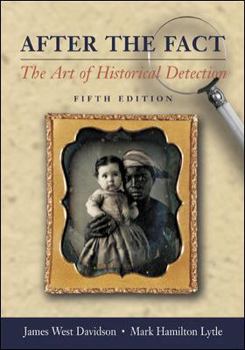After the Fact: The Art of Historical Detection
Select Format
Select Condition 
Book Overview
For more than twenty years, After the Fact has been a popular and best-selling approach to guiding students through American History and the methods used to generate it. In fifteen dramatic episodes... This description may be from another edition of this product.
Format:Paperback
Language:English
ISBN:0072818522
ISBN13:9780072818529
Release Date:January 2004
Publisher:McGraw-Hill Companies
Length:487 Pages
Weight:1.55 lbs.
Customer Reviews
6 ratings
Missing Pages
Published by Katherine , 3 years ago
My copy of the book had several pages torn out of it. This was intended to be used as a textbook for a Historian Theory class I was taking.
The Hobo Philosopher
Published by Thriftbooks.com User , 15 years ago
I am one of the lucky ones that stumbled onto vol I and vol II of After The Fact. In these books the authors look at history as a detective story. They take the facts and then read between the lines to try and figure it all out. Their technique is basically how I always looked at history. Every historian has a point of view. The true story is rarely right there in any book in black and white - it is between the lines. And often between the lines of several different books. The truth must be hunted out. And you hunt it out by asking objective, rational questions. It is a great and refreshing approach to learning history. Books written by Richard Noble: "Hobo-ing America: A Workingman's Tour of the U.S.A.." "A Summer with Charlie" "A Little Something: Poetry and Prose" "Honor Thy Father and Thy Mother"
History made exciting
Published by Thriftbooks.com User , 16 years ago
For those lucky enough to stumble upon this volume on historical methods, an exciting array of stories awaits you. This book was supplemental reading in my introduction to history class. I've always enjoyed history but never more so than when I scanned the chapters of "After the Fact". Each story brings the past to life and calls into question the nature of historical interpretation and analysis. Far from a dry text book, "After the Fact" will leave the lay historian wanting more, which can be found in Volume II. For those that enjoy this book, also check out "In Small Things Forgotten: An Archaeology of Early American Life" by James Deetz. I highly recommend both but the $63.00 price tag is rediculous.
History, After the Fact
Published by Thriftbooks.com User , 18 years ago
Davidson and Lytle's book is a study in historiography dealing with the interpretation and analysis of the sources used to report history. The authors concentrate on the several types of sources and the drawbacks of each, specifically biases. Examples include written, oral, video, psycho, cultural, economic and political history. This version includes an investigative CD which enhances the lessons in the book. After the Fact is a good companion to Richard Evans' In Defense of History, David Fischer's Historians' Fallacies, and Mark Gilderhus' History and Historians.
History as Art
Published by Thriftbooks.com User , 18 years ago
Anyone interested in history would enjoy this book, and learn from it, too. History is the story we tell about the past, and how the story is told is an art. The best historical art expresses truth and insight, and helps us to understand ourselves and others. When one considers that virtually all of our knowledge and perceptions, including scientific, are based on the stories we hear and believe, the art of history gains respect. The authors of After the Fact offer fifteen chapters on various historical topics, not so much for the purpose of writing history as of thinking about history. The authors' opinions about the topics are therefore not so important, and it really doesn't matter whether you agree with them, though I found all of them quite interesting and insightful. This book complements standard history books and is a great change of pace.
A Great Introduction
Published by Thriftbooks.com User , 23 years ago
After the Fact is a fantastic introduction to the field of historiography. It is a very easy read as well as providing concrete examples of how writing history is a selective act, dealing with different kinds of evidence, and the general practices and problems of historical methods. I would recommend using this book in an introductory history course because of its understandability. It would serve as a good introduction to beginning historians to the problems and philosophical concerns of their field.





